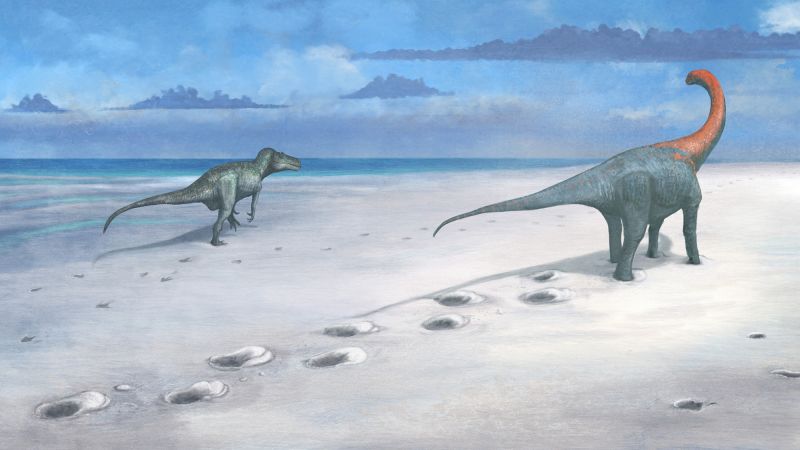In a remarkable fossil discovery, scientists have unearthed nearly 200 dinosaur footprints dating back approximately 166 million years, resting in the depths of Dewars Farm Quarry located in Oxfordshire, England. This exceptional find, unearthed in 2023 by quarry worker Gary Johnson, who reported unusual bumps on the surface while extracting limestone for local road construction, has been aptly nicknamed the “dinosaur highway.” The term reflects the extensive network of pathways the dinosaurs left as they roamed the landscape during the Middle Jurassic Period.
The discovery at Dewars Farm Quarry is extraordinary, considering that while various Jurassic pathways have been documented globally, this location is recognized as the largest dinosaur track site in the United Kingdom. Encouragingly, a group of around 100 volunteers from the University of Birmingham and the University of Oxford joined forces in June to excavate these intriguing tracks, meticulously documenting data about the large expanse of the site. This prehistoric finding is particularly noteworthy as it coincides with the 200th anniversary of the first documented dinosaur, Megalosaurus, which was discovered in Oxfordshire in 1824.
Kirsty Edgar, a professor of micropaleontology at the University of Birmingham and a participant in the excavation, remarked on the long legacy of significant dinosaur tracks and fossils in the region. The newly discovered tracks connect to a previously known dinosaur path in the same quarry, which was uncovered back in 1997 but is now inaccessible. Notably, the modern technology available to researchers today will enable them to analyze information that was previously uncharted, providing insight into these ancient creatures’ movements, diets, and social behaviors.
During the excavation phase, scientists unearthed five distinct trackways, with the longest pathway stretching over 150 meters, equivalent to approximately 492 feet. Four of these paths revealed impressions made by colossal, long-necked herbivorous dinosaurs of the sauropod subgroup, specifically the Cetiosaurus, which could grow up to 18 meters (around 59 feet) long. The largest footprints measured an impressive 90 centimeters (roughly 35 inches) long.
Comparing sauropods to contemporary elephants, Lawrence Tanner, a paleoecologist and professor at Le Moyne College in Syracuse, New York, explained that most footprints belonged to the hind feet, which were larger and commonly covered the impressions left behind by the front feet, similar to how elephants walk. According to Tanner, a significant rule of locomotion is that the swifter the animal, the farther apart the footprints will be. Meanwhile, a fifth pathway revealed tracks from the predator Megalosaurus, a massive dinosaur reaching lengths of about 9 meters (approximately 30 feet), with its footprints measuring around 65 centimeters (2.1 feet) long.
Tracking the movements of these dinosaurs, researchers discovered that most of them were moving northeast at an average pace of 5 kilometers per hour (about 3 miles per hour), which is akin to the speed of a human walking. Interestingly, it appears that larger theropods like the Megalosaurus lacked the capability to run swiftly, unlike their smaller counterparts which likely had greater speed; this was inferred from the leisurely pace indicated by their prints. Notably, the Megalosaurus’ path intersected with the sauropod trackways, suggesting that predators utilized the same areas shortly after herbivores’ movements.
The ancient environmental conditions of the Jurassic period played a significant role in preserving these extensive tracks, as the area is thought to have been covered with soft sediment and an ideal amount of water, creating the perfect conditions for impression conservation. Edgar noted that the environmental conditions were akin to Florida’s wetland regions, which supported the formation and preservation of these footprints.
Documentation of these tracks offers specific insights into dinosaur behavior and group dynamics, revealing how they interacted with their environment. Unlike bones, which may be moved by natural forces, footprints hold the exact location of where they were made, allowing for detailed analyses of behavior patterns such as predator-prey interactions and reactions to changes in their surroundings. During the excavation, over 20,000 images were taken using aerial drone technology, which researchers will utilize to create comprehensive 3D models for further investigation.
Over the coming months, the team is dedicated to swiftly analyzing the data collected and preparing to share their findings with the public. Edgar highlighted the exciting milestone of generating 3D models for widespread viewing upon publication, capturing a rich legacy of life that once thrived at Dewars Farm Quarry. As quarry activities continue, researchers are hopeful to conduct further excavations each summer in pursuit of uncovering more information about the once-diverse fauna that populated the area millions of years ago.



